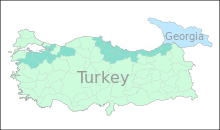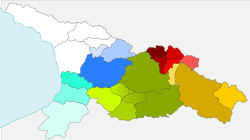Georgians in Turkey
Georgians in Turkey (Georgian: ქართველები თურქეთში) refers to citizens and denizens of Turkey who are, or descend from, ethnic Georgians.
 Map of ethnic Georgians significant distribution in Turkey | |
| Total population | |
|---|---|
| 100,000[1][2] | |
| Regions with significant populations | |
| Black Sea Region, Marmara Region, Eastern Anatolia Region | |
| Languages | |
| Georgian, Turkish | |
| Religion | |
| Predominantly Sunni Islam | |
| Related ethnic groups | |
| Laz people |
Numbers and distribution
| Year | As first language | As second language | Total | Turkey's population | % of Total speakers |
|---|---|---|---|---|---|
| 1935 | 57,325 | 16,255 | 73,580 | 16,157,450 | 0.46 |
| 1945 | 40,076 | 9,337 | 49,413 | 18,790,174 | 0.26 |
| 1950 | 72,604 | 0 | 72,604 | 20,947,188 | 0.35 |
| 1955 | 51,983 | 24,720 | 76,703 | 24,064,763 | 0.32 |
| 1960 | 32,944 | 54,941 | 87,885 | 27,754,820 | 0.32 |
| 1965 | 34,330 | 44,934 | 79,234 | 31,391,421 | 0.25 |
In the census of 1965, those who spoke Georgian as first language were proportionally most numerous in Artvin (3.7%), Ordu (0.9%) and Kocaeli (0.8%).
Georgians live scattered throughout Turkey, although they are concentrated on two major regions of residence:[4]
- Black Sea coast, in the provinces Giresun, Ordu, Samsun, and Sinop, with extension to Amasya and Tokat. Chveneburi, particularly in Fatsa, Ünye, Ordu, Terme, and Çarşamba, largely preserve their language and traditions.
- Northwestern Turkey, in the provinces Düzce, Sakarya, Yalova, Kocaeli, Bursa, and Balıkesir.
Magnarella estimated the number of Georgians in Turkey to have been over 60,000 in 1979.[5]
Imerkhevians

Imerkhevians (Shavshetians) are an ethnographic subgroup of Georgians who speak the Imerkhevian dialect (imerkheuli) of the Georgian language, which shares many common features with the neighboring Adjarian.[6] Imerkhevians are indigenous population of Artvin Province.
The majority of the Imerkhevians today live in an area they call Imerkhevi, the name of the cultural region traditionally inhabited by the Imerkhevian. The population of Imerkhevi is largely composed of ethnic Georgians, who inhabit 14 hamlets around Meydancık, formerly known as Diobani. These settlements have both official Turkish and unofficial Georgian names. Reflecting some internal differentiation persisting in Turkey's Georgian community, the Imerkhevians claim a different origin from the Georgians in the Borçka area, who have adopted an inclusive Adjar identity. The Imerkhevians are Sunni Muslims, closely integrated with the Turkish society. Almost all are bilingual in Georgian and Turkish.
Chveneburi
Chveneburi had arrived in Turkey basically in three waves of migration due to pogroms and what is now termed ethnic cleansing of Caucasians by the Russian Empire. The first wave was during and after the Russo-Turkish War, 1828-1829 when the Sublime Porte consigned its sovereignty over several parts of Georgia to the Russian Empire.
Minor immigrations had also followed until the end of Russo-Turkish War, 1877–1878 when Ottoman Empire allowed Chveneburis to immigrate, the major wave of immigration involved at least 500,000 people from historic Georgian regions that had considerable Muslim populations such as Batumi and Kars.[7] This wave of being muhajirs, known as muhajiroba (მუჰაჯირობა) had left many Muslim-majority regions of Georgia virtually depopulated.
The last sizable wave of immigration was in 1921 when Turkey finally gave up its claims on Adjara in the Treaty of Kars with the Soviet republics. This last wave also involved Turkish-speaking Muslims from Upper Adjara. Adjarians were also known by their places of origin, such as Batumlular for people from Batumi, Çürüksulular for people from Kobuleti.
Chveneburi (Georgian: ჩვენებური, çveneburi), meaning "of us" in Georgian, is an autonym of Muslim immigrants of Georgian descent who had settled in non-Georgian majority regions of Turkey, thus, "of us" signifies a triple distinction from Christian Georgians, Muslim Turks, and autochthonous Muslim Georgians from Artvin. As with most Turkish citizens, most Chveneburi subscribe to the Hanafi madh'hab of Sunni Islam.
Press
The most important Georgian cultural magazine in Turkey also bears the name Çveneburi. It was founded in 1977 in Stockholm, Sweden by Shalva Tevzadze. It is distributed in Turkey by Ahmet Özkan Melashvili, who also wrote the book Gürcüstan (Georgia) in 1968. In 1980, Özkan was assassinated in Bursa by the Grey Wolves.[9] Since then, Fahrettin Çiloğlu has been in charge of the magazine (1993). Between 1997 and 2006, Osman Nuri Mercan was the editor of the magazine. The magazine's content is almost completely in Turkish and presents articles on Chveneburi as well as the present situation and the history of Georgia and Georgians worldwide. Another journal, Pirosmani, bilingual in Georgian and Turkish, is published in Istanbul, sponsored by theGeorgian Catholic Simon Zazadze.
Group identity
Group identity is shaped basically by the schism with Christian Georgians. Chveneburi usually restrain from using the word Kartveli (ქართველი) as a self-designation because they think it indicates being a Christian.[10] They prefer to use Gurji (Gürcü) (გურჯი) when referring to their more precise ethnic background.
Intermarriage with other Sunni groups is common. In some regions, specifically Ünye for instance, Chveneburi women are sought-after brides, seen by the local rural Turkish population as beautiful and hard-working wives. This phenomenon further accelerates cultural and linguistic assimilation of the community.
Laz people
Laz people are an indigenous Kartvelian-speaking ethnic group[11] inhabiting the Black Sea coastal regions of Turkey and Georgia.[12] Estimates of the total population of the Laz people today vary drastically, with numbers as low as 45,000 to as high as 1.6 million people, with the majority living in northeast Turkey. The Laz speak the Laz language, a member of the same Kartvelian language family as Georgian, Svan, and Mingrelian.[13][14]
See also
References
- The Other Languages of Europe: Demographic, Sociolinguistic, and Educational Perspectives, p. 420, at Google Books
- Ethnic Groups Worldwide: A Ready Reference Handbook, p. 291, at Google Books
- Fuat Dündar, Türkiye Nüfus Sayımlarında Azınlıklar, 2000
- "Türkiye'deki Gürcü Köylerinde Alan Çalışmasının Sonuçları". Çveneburi. Retrieved 28 May 2014.
- Peter A. Andrews & Rüdiger Benninghaus (1989), Ethnic Groups in the Republic of Turkey, Vol. 1, p. 174. Reichert, ISBN 3-88226-418-7.
- Tuite, Kevin (1998), Kartvelian morphosyntax: number agreement and morphosyntactic oritntation in the South Caucasian languages, p. 178. Lincom Europa.
- "Muhacir Gürcüler yada Çveneburiler - მუჰაჯირი ქართველები ან ჩვენებურები". Çveneburi. Retrieved 28 May 2014.
- BERAT YILDIZ, EMIGRATIONS FROM THE RUSSIAN EMPIRE TO THE OTTOMAN EMPIRE: AN ANALYSIS IN THE LIGHT OF THE NEW ARCHIVAL MATERIALS, BILKENT UNIVERSITY
- .
- James S. Olson (1994). Lee Brigance Pappas; Nicholas Charles Pappas (eds.). An Ethnohistorical Dictionary of the Russian and Soviet Empires. Greenwood. p. 436.
- 1 Minorsky, V. "Laz." Encyclopaedia of Islam, Second Edition. Edited by: P. Bearman , Th. Bianquis , C.E . Bosworth , E. van Donzel and W.P. Heinrichs. Brill, 2010.
- Dalby, A. (2002). Language in Danger; The Loss of Linguistic Diversity and the Threat to Our Future. Columbia University Press. p. 38.
- BRAUND, D., Georgia in antiquity: a history of Colchis and Transcaucasian Iberia 550 BC – AD 562, Oxford University Press, p. 93
Bibliography
- Black Sea: Encyclopedic Dictionary (Özhan Öztürk. Karadeniz: Ansiklopedik Sözlük. 2. Cilt. Heyamola Publishing. Istanbul. 2005. ISBN 975-6121-00-9.)
- Paul J. Magnarella, The Peasant Venture: Tradition, Migration and Change among Georgian Peasants in Turkey. (Schenkman Publishing Company: Cambridge, MA, 1979) ISBN 0-8161-8271-X
- Mikaberidze, Alexander (ed., 2007). Özkan, Ahmet. Dictionary of Georgian National Biography.
External links
- Chveneburi
- Pirosmani / ფიროსმანი
- Gezgin, Ulas Basar (2004) Republican and Post-Republican Responses to New Georgian Nationalisms (PhD Proposal in Anthropology). teori.org (includes a list of selected publications on the Georgian communities of Turkey)
| Wikimedia Commons has media related to Georgians in Turkey. |